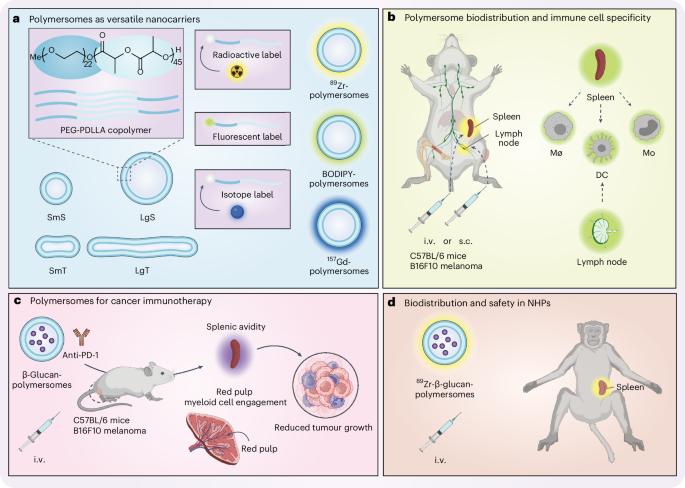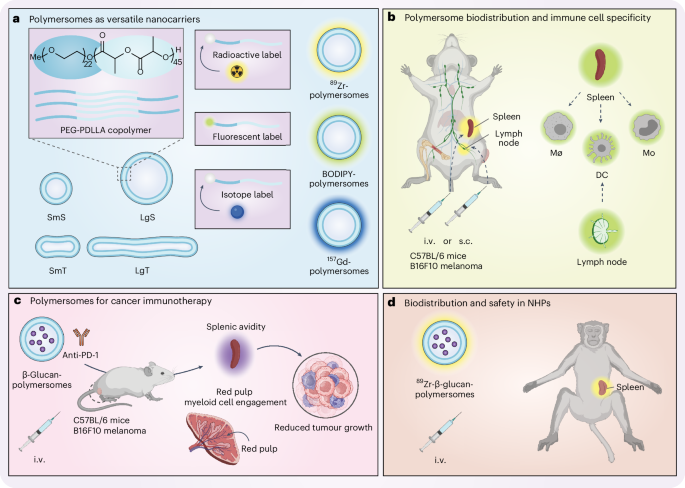具有脾脏亲和性的聚合体靶向红髓髓细胞,用于癌症免疫疗法
IF 38.1
1区 材料科学
Q1 MATERIALS SCIENCE, MULTIDISCIPLINARY
引用次数: 0
摘要
调节先天性免疫是改善癌症免疫疗法的一种新兴方法。这种调节需要通过向包括脾脏在内的造血器官输送免疫调节化合物来吸引髓系细胞。在这里,我们介绍了一种基于聚合物组的纳米载体,它具有脾脏亲和性和红髓髓系细胞摄取倾向。我们通过体内正电子发射断层扫描成像以及创新的流式和质谱技术,对四种化学性质相同但拓扑结构不同的聚合体的体内行为进行了表征。静脉给药后,相对较大的球形聚合体在脾脏中迅速聚集,并有效靶向脾脏红髓中的髓样细胞。当载入β-葡聚糖时,静脉注射聚合体可显著减少小鼠黑色素瘤模型中的肿瘤生长。我们通过在非人灵长类动物中进行生物分布研究,启动了纳米疗法的临床转化。本文章由计算机程序翻译,如有差异,请以英文原文为准。


Polymersomes with splenic avidity target red pulp myeloid cells for cancer immunotherapy
Regulating innate immunity is an emerging approach to improve cancer immunotherapy. Such regulation requires engaging myeloid cells by delivering immunomodulatory compounds to hematopoietic organs, including the spleen. Here we present a polymersome-based nanocarrier with splenic avidity and propensity for red pulp myeloid cell uptake. We characterized the in vivo behaviour of four chemically identical yet topologically different polymersomes by in vivo positron emission tomography imaging and innovative flow and mass cytometry techniques. Upon intravenous administration, relatively large and spherical polymersomes accumulated rapidly in the spleen and efficiently targeted myeloid cells in the splenic red pulp. When loaded with β-glucan, intravenously administered polymersomes significantly reduced tumour growth in a mouse melanoma model. We initiated our nanotherapeutic’s clinical translation with a biodistribution study in non-human primates, which revealed that the platform’s splenic avidity is preserved across species. Delivering immunomodulatory compounds to myeloid cells can activate innate immunity for cancer immunotherapy. Here the authors design a polymersome-based nanocarrier for delivering β-glucan to red pulp myeloid cells in the spleen and show that their strategy achieves tumour growth reduction in a melanoma model.
求助全文
通过发布文献求助,成功后即可免费获取论文全文。
去求助
来源期刊

Nature nanotechnology
工程技术-材料科学:综合
CiteScore
59.70
自引率
0.80%
发文量
196
审稿时长
4-8 weeks
期刊介绍:
Nature Nanotechnology is a prestigious journal that publishes high-quality papers in various areas of nanoscience and nanotechnology. The journal focuses on the design, characterization, and production of structures, devices, and systems that manipulate and control materials at atomic, molecular, and macromolecular scales. It encompasses both bottom-up and top-down approaches, as well as their combinations.
Furthermore, Nature Nanotechnology fosters the exchange of ideas among researchers from diverse disciplines such as chemistry, physics, material science, biomedical research, engineering, and more. It promotes collaboration at the forefront of this multidisciplinary field. The journal covers a wide range of topics, from fundamental research in physics, chemistry, and biology, including computational work and simulations, to the development of innovative devices and technologies for various industrial sectors such as information technology, medicine, manufacturing, high-performance materials, energy, and environmental technologies. It includes coverage of organic, inorganic, and hybrid materials.
 求助内容:
求助内容: 应助结果提醒方式:
应助结果提醒方式:


